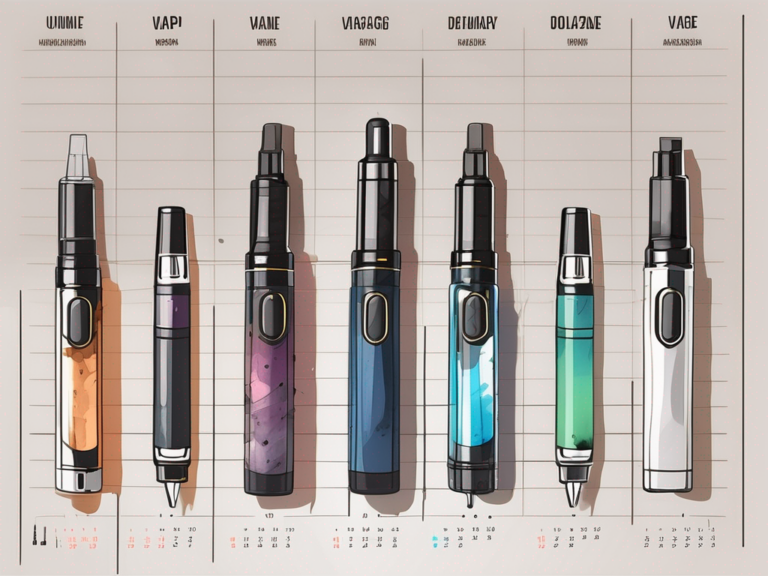which vapes are safe
Vaping has become an increasingly popular alternative to traditional smoking. However, there is growing concern about the safety of vaping devices and e-liquids. In this article, we will explore the different aspects of vaping safety and provide useful information to help you make an informed decision about which vapes are safe for you.
Understanding the Basics of Vaping
What is Vaping?
Vaping refers to the act of inhaling aerosol produced by a vaping device, commonly referred to as a vape, e-cigarette, or e-cig. This aerosol is generated by heating e-liquids that usually contain nicotine, flavorings, and other chemicals. Vaping devices come in various shapes and sizes, but they all work on the same principle of heating and delivering the e-liquid.
Vaping has gained popularity as an alternative to traditional smoking, with many users citing it as a way to reduce or quit smoking. The act of vaping is often referred to as “cloud chasing” among enthusiasts, who enjoy producing large vapor clouds with their devices. While vaping is generally considered less harmful than smoking traditional cigarettes, it is not without risks, especially for non-smokers and young people.
Components of a Vape
Vapes consist of several key components, including a battery, a heating element (often referred to as a coil), a tank or cartridge to hold the e-liquid, and a mouthpiece. When the user activates the vape, the battery powers the heating element, which then vaporizes the e-liquid, allowing the user to inhale the aerosol.
The heating element in a vape is crucial for producing vapor. It comes in various materials like kanthal, stainless steel, nickel, or titanium, each affecting the vaping experience differently. Some vapers prefer a warmer vapor, while others prioritize flavor purity. Choosing the right coil material can significantly impact the overall enjoyment of vaping.
Different Types of Vapes
There are several types of vapes available on the market today. The most common types include cigalikes, pod systems, vape pens, and box mods. Each type has its own unique features and functionalities, catering to different vaping preferences and experiences. It’s essential to understand the differences between these types to ensure a safe vaping experience.
Cigalikes are small, lightweight devices that resemble traditional cigarettes, making them a popular choice for beginners. Pod systems are compact and easy to use, with disposable or refillable pods. Vape pens are pen-shaped devices that offer portability and simplicity. Box mods are larger and more customizable, allowing users to adjust settings like wattage and temperature for a personalized vaping experience.
The Health Risks Associated with Vaping
Vaping has gained popularity as a perceived less harmful alternative to smoking traditional cigarettes. However, it is crucial to recognize that vaping is not without its risks. While some may argue that vaping is a safer option due to the absence of tobacco combustion, it is essential to delve deeper into the potential health implications associated with this practice.
Short-term Effects of Vaping
Short-term effects of vaping can manifest as irritation of the throat and mouth, coughing, and an increase in heart rate. These immediate consequences may deter individuals from recognizing the potential long-term risks associated with vaping. Moreover, reports of respiratory issues and rare cases of lung damage have surfaced, underscoring the importance of further research to comprehensively understand the short-term impacts of vaping on human health.
Long-term Effects of Vaping
As vaping continues to permeate society, researchers are diligently studying the long-term effects of this practice. Preliminary findings suggest that prolonged and heavy vaping may lead to adverse health outcomes, including an elevated risk of developing respiratory and cardiovascular diseases. The evolving landscape of vaping underscores the necessity of ongoing research to elucidate the potential long-term health ramifications associated with this modern phenomenon.
Vaping vs Traditional Smoking
Comparatively, vaping is often positioned as a safer alternative to traditional smoking, primarily due to the absence of tobacco combustion. Traditional cigarettes involve the burning of tobacco, resulting in the release of harmful substances such as tar and carbon monoxide, which are known to have detrimental effects on health. In contrast, vapes do not produce smoke and do not engage in the combustion of tobacco, potentially reducing exposure to harmful byproducts. Nonetheless, it is imperative to recognize that while vaping may present fewer immediate risks than traditional smoking, it is not devoid of health concerns, necessitating a comprehensive evaluation of the potential health impacts of vaping.
Evaluating the Safety of Different Vapes
Material and Build Quality
The material and build quality of a vape device play a significant role in its safety. Vapes made from high-quality materials, such as stainless steel or glass, are generally safer than those made from cheaper materials that may contain harmful substances. It’s important to choose vapes from reputable manufacturers and prioritize devices that undergo thorough quality control measures.
When considering the material and build quality of a vape, it’s essential to pay attention to details such as the type of seals used, the presence of any exposed wiring, and the overall construction of the device. Devices with proper seals and well-secured components are less likely to leak or malfunction, enhancing both safety and user experience. Additionally, vapes with user-friendly designs that make it easy to access and clean components can contribute to the longevity and safety of the device.
Battery Safety
Battery safety is of utmost importance when it comes to vaping. Poorly manufactured batteries or mishandling of batteries can lead to serious accidents, such as explosions or fires. It is crucial to follow the manufacturer’s instructions regarding battery usage and storage, and to avoid using damaged batteries. Regularly inspecting and properly maintaining your vape device can help prevent battery-related incidents.
When it comes to battery safety, it’s not just the quality of the battery that matters, but also how well the device manages and regulates power. Vapes with built-in safety features such as short circuit protection, overcharge protection, and temperature control can provide an added layer of security during use. Understanding the capabilities of your device and how to safely operate it can significantly reduce the risk of battery-related accidents.
E-liquid Ingredients
The ingredients used in e-liquids vary greatly. While many reputable e-liquid manufacturers strive to use high-quality ingredients, some products may contain potentially harmful additives. It is advisable to research the ingredients of the e-liquids you intend to use and opt for products that have undergone third-party testing for safety and purity.
Aside from individual ingredients, the overall formulation and manufacturing process of e-liquids can impact their safety profile. E-liquids that are produced in facilities that adhere to strict quality control standards and good manufacturing practices are more likely to be free from contaminants and inconsistencies. Choosing e-liquids from established brands with a track record of transparency and commitment to product safety can help consumers make informed decisions about their vaping experience.
Regulatory Standards for Vape Products
FDA Regulations on Vaping
The U.S. Food and Drug Administration (FDA) plays a crucial role in regulating certain aspects of the vaping industry within the United States. While the FDA has taken steps to regulate aspects of vape products, it is important to note that comprehensive regulations covering all vape products are still in development. This evolving regulatory landscape can lead to variations in product quality and safety standards across the industry. Vapers are encouraged to stay vigilant and informed about any updates or changes in FDA regulations pertaining to vaping to make well-informed choices about the products they use.
One of the key areas of focus for the FDA is the regulation of e-liquids, which are central to the vaping experience. The agency scrutinizes the ingredients used in e-liquids, particularly nicotine levels, to ensure they meet safety standards. Additionally, the FDA monitors labeling practices to prevent misleading information that could potentially harm consumers. By addressing these critical areas, the FDA aims to enhance consumer safety and promote transparency within the vaping market.
International Safety Standards for Vapes
Outside the United States, various international organizations and countries have established stringent safety standards and regulations for vaping products. These comprehensive standards encompass a wide range of factors, including product quality, manufacturing processes, and labeling requirements. Vapers seeking assurance about the safety of their chosen products are advised to opt for vapes that adhere to recognized international safety standards. This proactive approach can help consumers make informed decisions and prioritize their well-being when selecting vaping products.
Moreover, international safety standards often emphasize the importance of product testing and certification by accredited bodies. By obtaining certifications from reputable organizations, vape manufacturers demonstrate their commitment to meeting rigorous safety criteria. Consumers can look for these certifications as indicators of product reliability and adherence to established safety protocols. Embracing internationally recognized safety standards underscores the global effort to promote responsible vaping practices and protect consumer health.






